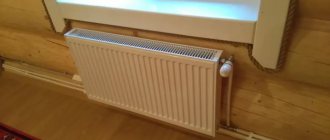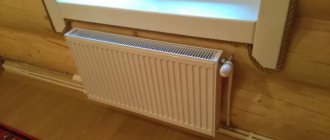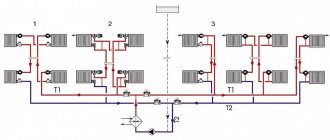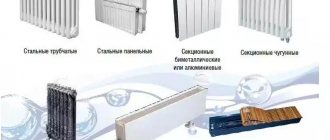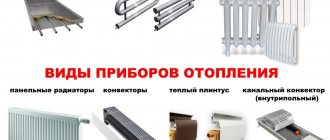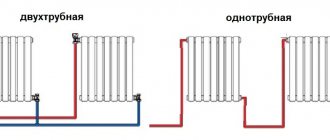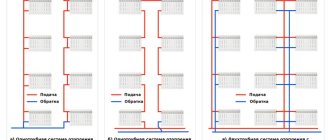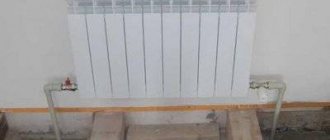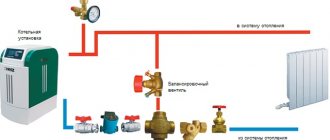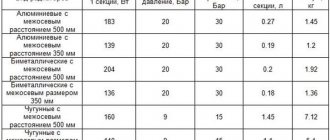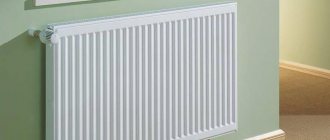The ability to regulate the temperature of heating radiators allows you to create a pleasant microclimate in the room and significantly save on utility bills in winter.
heating adjustment
The cost of coolants increases from year to year, so you need to know how to regulate the temperature of a heating battery in order to do it yourself, without involving expensive specialists. The uniformity of heating of all rooms in the home depends on the quality of this work.
The need to adjust heat transfer
There are two reasons why heating radiators need to be adjusted:
- Reducing home heating costs. True, in an apartment located in a multi-storey building, it is possible to reduce the amount of payments only if there is a common building heat meter. In a private household, if an automated boiler is installed, installation of regulators is unlikely to be required. The amount of savings will be significant.
- There is a need to maintain the desired temperature in the premises. For example, in one room it may be 17 degrees Celsius, and in another – 25 degrees. To do this, you need to set the appropriate numbers on the thermal head or close the valve.
In this case, it does not matter how the heated coolant enters the radiators - centrally or autonomously. It also does not matter which heating unit is installed in the system. The fact is that the regulators on the batteries are not connected to the boilers - they function independently.
Disadvantages of a one-pipe system
The disadvantages include the fact that with such a system it is impossible to take into account the heat consumption in each apartment. And, therefore, make an individual calculation of payment for the actual consumption of thermal energy. In addition, with such a system it is difficult to maintain the same air temperature in all living areas of the building.
That is why other apartment heating systems are used, which are designed differently and require the installation of heat energy meters in each apartment.
Currently, there are various apartment heating systems. However, so far they are installed in multi-storey buildings extremely rarely. This is due to a number of reasons. In particular, due to the fact that such systems have low hydraulic and thermal stability.
Most often, in multi-storey residential buildings, so-called central heating is used.
In recent years, autonomous heating has been used in the construction of new residential buildings. With this method of individual heating, the boiler room is installed directly in the basement or attic of a high-rise building. In turn, heating systems are divided into open and closed. The first provide for the division of hot water supply for residents for heating and other needs, and in the other - only for heating.
Adjusting heating radiators
To understand the question of how to regulate heating batteries with a regulator, first of all, you should find out the principle of their operation. By design, the radiator consists of a labyrinth of pipes and fins of various types, which provide increased heat transfer.
Hot liquid enters the device, passes through the labyrinth and thereby heats the metal, which gives off heat to the surrounding air. The fins on modern radiators are made of a special shape, which improves the convection of air flows, and the room is heated quickly.
In the case of active heating from the batteries, a heat flow is felt. This means that when you change the amount of coolant passing through the device, you can adjust the room heating temperature, albeit within certain limits.
This is what special fittings are designed for - thermostats and valves. But a heating regulator installed on a radiator in an apartment is not capable of increasing heat transfer; it can only reduce it.
The effectiveness of changing battery temperature depends on:
- on whether the heating devices have power reserves;
- from the correct selection and installation of regulators.
Of no small importance is the inertia of the entire heating system and the batteries themselves. For example, cast iron, which has a large mass, changes temperature slowly, while aluminum heats up quickly and cools down the same way. This means that there is no point in having cast iron radiators with temperature control, since it takes a long time to get results.
Removing air through a bleeder in aluminum, bimetallic and cast iron batteries
The advantages of aluminum batteries are their affordable price and excellent thermal conductivity. But aluminum is not a very good heating material due to its ability to react and release hydrogen. When such a battery is air-filled, a Mayevsky crane will help solve the problem of dumping excess air. In order to expel hydrogen from the inside, such batteries are covered with a special film, but this is only enough for a while, and then the gas is not removed.
Bimetallic radiators are another great invention. Where the internal parts touch the water, a different metal is used, and the fins are made of aluminum. In cases where a thermostat is installed on the radiator, opening it allows you to bleed the system and release oxygen. The airing of such radiators is similar to other types.
Cast iron batteries are also vented through a Mayevsky tap or an automatic air vent, thanks to which plugs in the pipes can be removed.
Ways to increase the heat transfer of batteries
The presence/absence of the opportunity to increase heat transfer depends on the calculation of the radiator power reserve. If the device is not able to produce more thermal energy, then no fittings will help.
You can try to change the situation in one of the following ways:
- First of all, you should check whether the filters and pipes are clogged. Blockages form both in old buildings and in new buildings, as various construction debris enters the system. When cleaning does not produce results, drastic measures need to be taken.
- Increase in coolant temperature. This can be done if there is an autonomous heating supply, but with centralized heating it is unlikely.
- Changing the connection type. Not all battery connection methods are equally effective. For example, a reverse side connection reduces power by about a quarter. The location of installation of the device also affects the heat transfer.
- Increasing the number of sections. If the location and method of connecting radiators are chosen correctly, and the room is also cold, this means that the thermal power of the devices is not enough. Then it is necessary to increase the number of sections.
If the heating system is equipped with batteries with temperature control, then they require a certain power reserve and this is their main drawback. As a result, heating installation costs increase, since each section costs money.
Comfort cannot be achieved if the room is cold or too hot, so adjusting the heat in radiators is a universal solution to this problem.
There are many devices on sale that are designed to change the volume of coolant passing through the radiator. Among them there are both inexpensive and high-cost products. They come with different adjustments: manual, electronic and automatic.
Heat Shield Materials
Foil foam is usually found in retail sales as short rolls. The thickness of the material layer in this case is up to 3 millimeters, and for foamed polyethylene – up to 4 millimeters. The thermal insulation properties of these materials are comparable to the properties of a 100 mm layer of mineral wool insulation.
When placing a screen that reflects heat, one can and should take into account such an important factor as the minimum distance between the edge of the radiator section of the battery and the inner wall, which is 4 mm. If you change this distance downward, it will complicate or disrupt the circulation of warm air and, as a result, convective heat transfer and the efficiency of the radiator.
Special cases of placing a heating battery on the wall do not allow the installation of a full-fledged screen that reflects heat. The way out of this situation is to mount aluminum foil on the wall, its shiny surface copes well with heat reflection. One sheet of such material, placed on a standard brick wall (if its thickness is 51 centimeters), will reduce the heat transfer loss of the battery by up to 35 percent.
The various methods discussed above for eliminating excess thermal energy from a battery can be taken into account as effective methods that have been proven in practice. If it gets too hot in the apartment, use what is said to make your home as comfortable as possible.
Ball Valves
Valves are cheap, but at the same time ineffective control devices. Ball valves are often installed at the entrance to the radiator, with the help of which they regulate the flow of water.
But this equipment also has another functionality - shut-off valves. Valves are used to completely shut off the flow of coolant into the system. For example, in the event of a leak in a heating device, ball valves located at the inlet and outlet of the radiator allow repairs to be made without stopping the heat supply and draining the liquid.
Heating radiators in the apartment cannot be adjusted using ball valves. They have only two positions - completely closed and open. An intermediate position only brings harm.
The fact is that inside such a faucet there is a ball with a hole, which in its normal position is not in danger, but in all other situations the solid particles present in the coolant grind it down and pieces break off from it. As a result, the tap will not be sealed and in the “closed” position, water will continue to flow into the battery, which can lead to big troubles if the device leaks.
If one of the property owners decides to control the radiators using ball valves, you must remember that they should be installed correctly.
This method is usually used in apartment buildings. If the wiring is single-pipe vertical, then the hot water pipe enters the room through the ceiling and a radiator is connected to it (read: “Correct adjustment of heating radiators in an apartment - comfort in the home and saving money”). The pipeline departs from the second entrance to the device and is directed through the floor to the room below.
In this case, it is necessary to install the taps correctly, since the installation of a bypass is mandatory. The bypass pipe is needed so that when the liquid flow to the radiator is closed, the coolant continues to circulate in the general house system.
In some situations, the tap is placed on the bypass to change the amount of water passing through it and thereby adjust the heat transfer of the battery. To ensure greater reliability of the heating system, at least three valves are installed: two will be shut-off valves on the radiator and function normally, and the third will become a regulating valve.
But here we must not forget what position the devices are in. Otherwise, you can completely block the riser and you will not be able to avoid the cold in the apartment, as well as unpleasant showdowns with neighbors and representatives of the management company.
Therefore, when deciding how to regulate heat in batteries, experts do not recommend using ball valves. There are other products on the market that are specifically designed to change the amount of water circulating through the radiator.
What else you should know
If you are wondering how to turn off the battery if there is no tap, then there is a solution here too. True, the option of blocking the riser is inevitable here. In this case, not only the individual battery will be blocked, but also part of the heating system. In small cities, the practice of turning off the heating independently is often used, just by shutting off the riser. It is turned off using a valve in the basement. At that point he approaches the sun lounger. Water valves are usually within sight.
You can find out which fittings are suitable for shutting off the heating in the technical documentation. Additionally, this should be known to an experienced plumber who is familiar with local utilities. In most cases, the heating system is shut off using a brass valve or a valve.
In the event that the window sill blocks the battery, there is no single solution. It all depends on the degree of overlap. So, for example, if the window sill completely blocked the battery, then this is considered unacceptable. This is explained by the concept of convection, in which warm air rises. There it replaces cold air, which goes down, after which it is heated by the battery. Thus, the room is heated. If the window sill completely blocks the radiator, then the convection process is hampered and the room does not warm up well. But there will definitely be a way out of this situation. You can make several rectangular holes in the window sill and cover them with decorative grilles.
- So, shutting off the batteries in an apartment is possible and, in some cases, even necessary. This can be most conveniently accomplished with special taps.
- After the end of the heating season, it is recommended to close one of them and leave the second open.
- On the day of heating, we close both taps for 1-2 days so that rusty water flows and eliminates the possibility of blockages.
- If there is no tap, then you will have to shut off the riser using a special valve or valve, which are most often located in the basement of the building, and usually in a visible place.
The main thing is to do everything thoughtfully and strictly in accordance with all standards and requirements. Do not close both taps at the end of the heating season, this may cause deformation and cracks in them. Do not forget about the basic rules that will help you shut off the battery in your apartment safely and correctly.
Needle valve
This device is usually installed in the heating system in front of the pressure gauge. The valve smoothly and effectively changes the flow of coolant, gradually blocking it. The design feature of this device is that the width of the passage in it is half as much.
For example, when installing inch pipes and the same cross-section of a needle valve, its capacity will be only ½ inch. As a result, each device built into the system reduces this parameter. Several products installed in series, for example in a single-pipe design, result in the latter devices being lukewarm or cold.
Since the passage is greatly narrowed, a needle device is not recommended to be installed when solving the problem of how to regulate the temperature of the battery, since its heat transfer is greatly reduced.
You can increase it as follows:
- removing the valve;
- doubling the number of sections;
- by installing a device that has twice as many couplings.
Control valves for radiators
To manually regulate the operation of heating devices, special valves are used. Such taps are sold with straight or angular connections. The procedure for regulating heating batteries using these devices manually is as follows.
When the valve is turned, the shut-off cone lowers or rises. In the closed position, the coolant flow is completely blocked. Moving up or down, the cone regulates to a greater or lesser extent the amount of circulating water.
Due to this operating principle, such valves are also called “mechanical temperature controllers”. They are installed on batteries with threads, and connected to pipes with fittings, most often of the crimp type.
The control valve used for heating devices has the following advantages:
- the device is reliable, it is not dangerous from blockages and fine abrasive particles present in the coolant - this applies exclusively to high-quality products in which the valve cone is made of metal and carefully processed;
- the product has an affordable price.
Control valves also have disadvantages - each time you use the device, its position has to be changed manually and for this reason it is quite problematic to maintain a stable temperature regime.
For those who are not satisfied with this procedure and are thinking about how to regulate the temperature of the radiator using another method, the use of automatic products that allow them to control the degree of heating of the radiators is more suitable.
Adjusting batteries using a thermostat
To ensure constant maintenance of the desired temperature in the room, thermostats for radiators are used. These devices have other names - thermostatic valve, thermostatic valve, etc. There are many names, but they all refer to one product.
The thermal valve and thermal valve are the lower part of the device, and the thermal head and thermoelement are the upper part. Most of these products operate without power sources. The exception is models equipped with a digital screen, in which batteries are placed in the thermostatic head. There is no need to change them often, since the current consumption is negligible.
The radiator thermostat consists of several components:
- thermostatic valve, which is called “housing”, “thermal valve”, “thermal valve”;
- thermostatic head or “thermostatic element”, “thermoelement”, “thermal head”.
The body (valve) is made of metal, usually bronze or brass. Externally, its design resembles a manual valve. Many manufacturers make the lower part of the radiator thermostat unified. This means that different types of heads can be mounted on one housing, regardless of their manufacturer.
Thus, it is possible to install a thermoelement with different controls on the thermal valve - manual, mechanical or automatic, which is very convenient. If you want to change the adjustment method, there is no need to buy the entire device, you just need to install a different thermostatic element.
Automatic regulators differ in the principle of influencing the locking mechanism. In a manual device, its position is changed by turning the handle. As for automatic models, they usually have a siphon that puts pressure on a spring-loaded mechanism. In electronic products, the workflow is controlled by a processor.
The bellows is the main element of the thermoelement (thermal head). It looks like a small sealed cylinder containing liquid or gas inside. Both of these substances have a common property - their volume depends on temperature. When heated, gas and liquid begin to significantly increase in volume and thereby stretch the cylinder.
The bellows, when pressed on the spring, blocks the flow of coolant. When the volume of the working medium decreases as it cools, the spring rises and thereby the fluid flow increases, and the radiator heats up again. Thanks to the use of such a device, depending on its calibration, the set temperature can be maintained with great accuracy - up to one degree.
Before using a radiator, anyone who decides to purchase a thermostat for it must decide what type of temperature control it should have:
- manual;
- auto;
- with built-in or remote sensor.
Models designed for one-pipe and two-pipe systems, with housings made of different metals, are also available.
Applications of three-way valves
One way to regulate heating radiators is to use a three-way valve. True, it is rarely used. Despite the fact that it is designed to solve other problems, such an application is possible.
Install a three-way valve at the junction of the bypass with the supply pipe going to the heating battery. To stabilize the temperature of the working environment, it must be equipped with a thermostatic head.
When the temperature near the head of the three-way valve becomes higher than the set parameter, the flow of liquid moving to the radiator is blocked - it is sent to the bypass. After the coolant cools down, the valve begins to operate in the opposite direction, and the battery heats up again. This connection method is usually implemented in single-pipe heat supply systems, with vertical wiring.
How to install a thermostat on a battery: step-by-step instructions
You will need:
- metal-plastic pipe with a diameter of 20 mm;
- 2 tees with 1/2″ thread;
- 6 American metal-plastic compression fittings;
- thermostat;
- ball valve
Procedure:
Unscrew the drive nut with an adjustable wrench and unscrew the old winding.
Clean the threads of the outlet so that the connection between the radiator and the pipe is clearly visible.
Perform the same operation with the lower connection. For ease of installation, remove the radiator and place it on a flat horizontal surface. Hold the radiator cap with one wrench and unscrew the tube with the second.
After this, remove the old seal from the hole, for example, with a screwdriver.
Now you need to assemble a bypass with a thermostat and a ball valve. Coat the threads of the compression fitting with silicone sealant until it fills all cavities.
Take 2 tees and 2 nipples and twist them together.
Screw the thermostat and ball valve to the nipple.
Install transition couplings from metal-plastic to metal into the tee. You should end up with a knot like this.
Screw it into the battery.
Do the same with the bottom connection.
For the bypass, cut off a section of metal-plastic pipe of the required length, after first removing the nuts from the compression fittings and measuring the distance.
Calibrate the edges, that is, remove the chamfers with a calibrator.
Place the nut and ferrule on the pipe and connect it to the ball valve and thermostat.
Do the same with the other end of the pipe. The jumper (bypass) is ready. Connect it to the radiator.
Hang the battery on the old mount and connect it to the riser. To do this, prepare 2 metal-plastic tubes. Don't forget to measure the length at the top and bottom - it often varies.
Remove the bypass from the radiator. Screw the tubes into the upper and lower nodes.
Install the bypass on the radiator, and the tubes in the riser outlets. At the top there is a thermostat for heating.
Below is a ball valve.
Tighten the nuts with an adjustable wrench. The radiator with thermostat can be put into operation.
Summarizing
You can regulate heating radiators using several types of devices, but experts believe that the best solution is to use special control valves. Such products are manual taps and automated products - thermostats, and only in some cases can a three-way valve with a thermal head be used.
In high-rise apartments with centralized heating, it is better to give preference to control taps or a three-way valve. As for individual heating systems, the problem of how to reduce the temperature of the coolant in a heating radiator is solved using thermostats.
If the apartment owner still prefers automatic adjustment of radiators, then a filter should be installed before the thermostat - it will trap most of the various impurities.
Malfunctions
In some cases, the operation of the device is disrupted by air pockets. They can be eliminated by bleeding the air using a Mayevsky valve. A decrease in heat transfer results from blockage of the pipe passage with sediment or rust. To get rid of dirt, it is recommended to rinse the radiator with special products.
In centralized systems, the temperature of the coolant may decrease as a result of an emergency on the main pipeline or unauthorized actions of neighbors that caused a change in the flow parameters in the common riser. Circulation is worsened by a broken valve at the radiator inlet or an incorrectly installed plug.
Since there are many reasons, before adjusting the heating batteries, you need to perform diagnostics taking into account all possible faults. Determining the cause is difficult, but possible. If the battery previously heated well and the riser is hot, the search for problems is narrowed to the radiator. We have an article about installing radiators with your own hands, read the link for more details.
Most likely it will be enough:
- release air;
- wash the battery from the inside;
- change the valve.
As a rule, after performing one or several actions, the previous heat transfer is restored.
